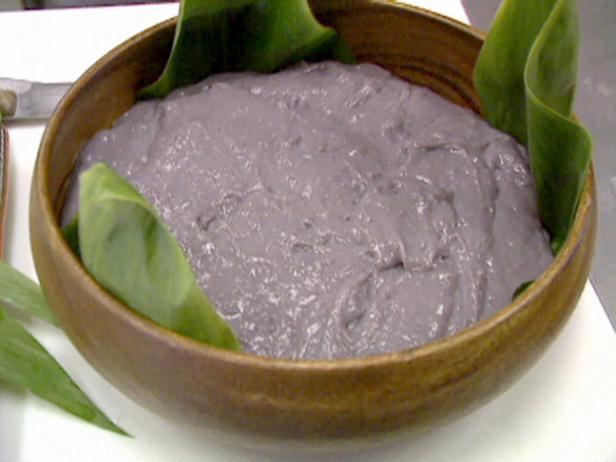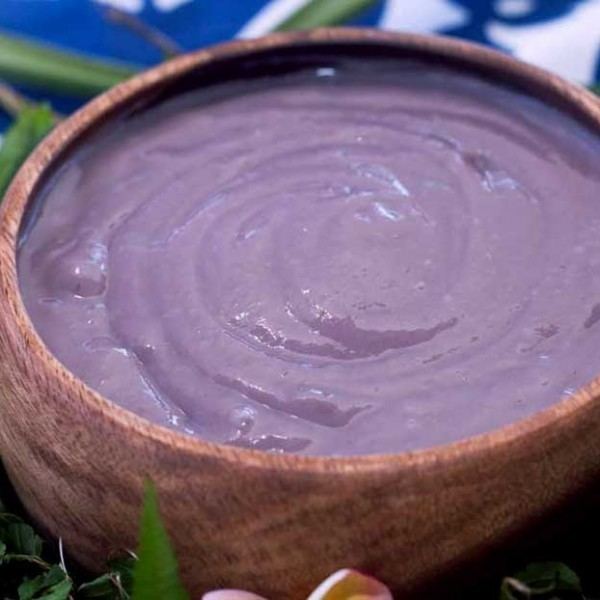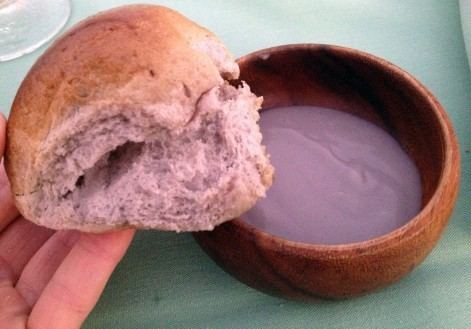 | ||
Similar Taro, Laulau, Lomi‑lomi salmon, Haupia, Poke | ||
Poi is a Hawaiian word for the primary Polynesian staple food made from the underground plant stem or corm of the taro plant (known in Hawaiian as kalo). It is a traditional part of Native Hawaiian cuisine.
Contents

Poi is produced by mashing the cooked corm (baked or steamed) until it is a highly viscous fluid. Water is added during mashing and again just before eating to achieve the desired consistency, which can range from liquid to dough-like. As such, poi can be known as "one-finger," "two-finger," or "three-finger" poi depending on the consistency, alluding to how many fingers are required to scoop it up in order to eat it. Poi can be eaten immediately when fresh and sweet, or left a bit longer to ferment.
Poi made from taro should not be confused with

History and culture

Taro, a root vegetable and the primary poi ingredient, was highly regarded by Hawaiians, who believed that the taro plant, or kalo, was the original ancestor of the Hawaiian people. Poi was considered such an important and sacred aspect of daily Hawaiian life that it was believed that the spirit of Hāloa, the legendary ancestor of the Hawaiian people, was present when a bowl of poi was uncovered for consumption at the family dinner table. Accordingly, all conflict among family members was required to come to an immediate halt.
Although many of the world's people consume taro, only Hawaiians make poi. Hawaiians traditionally cook the starchy, potato-like heart of the taro root for hours in an underground oven called an imu. An imu is also used to cook other types of food such as pork, carrots and sweet potatoes.
In recent years, taro-production shortages (resulting from pests and labor shortages) have resulted in higher prices for poi in Hawaiʻi. At the same time, innovations in poi production have resulted in poi that stays fresh longer and tastes sweeter. However, such products generally sell at a premium price and require refrigeration.
Food
Poi has a paste-like texture and a delicate flavor, with a pale purple color that derives from that of the taro corm. The flavor changes distinctly once the poi has been made. Fresh poi is sweet and edible all by itself. Each day thereafter the poi loses sweetness and turns slightly sour, due to a natural fermentation that involves lactobacillus, yeast, and Geotrichum. Therefore, some people find poi more palatable if it is mixed with milk and/or sugar. The speed of this fermentation process depends upon the bacteria level in the poi. To slow the souring process, poi can be stored in a cool, dark location. Commercial poi stored in a refrigerator can be squeezed out of the bag into a bowl, and a thin layer of water drizzled over the top to keep a crust from forming.
Sour poi is still edible, and is usually served with salted fish or lomi salmon on the side. Sourness is prevented by freezing or dehydrating, although the resulting poi tends to be bland in comparison to the fresh product. Sour poi is also used as a cooking ingredient, usually in breads and rolls. It has a smooth, creamy mouthfeel.
Special dietary and medical uses
Taro is low in fat, high in vitamin A, and abounds in complex carbohydrates.
Poi has been used as a milk substitute or baby food for babies. It contains no gluten, and as such is safe for ingestion by people with celiac disease or gluten intolerance.
